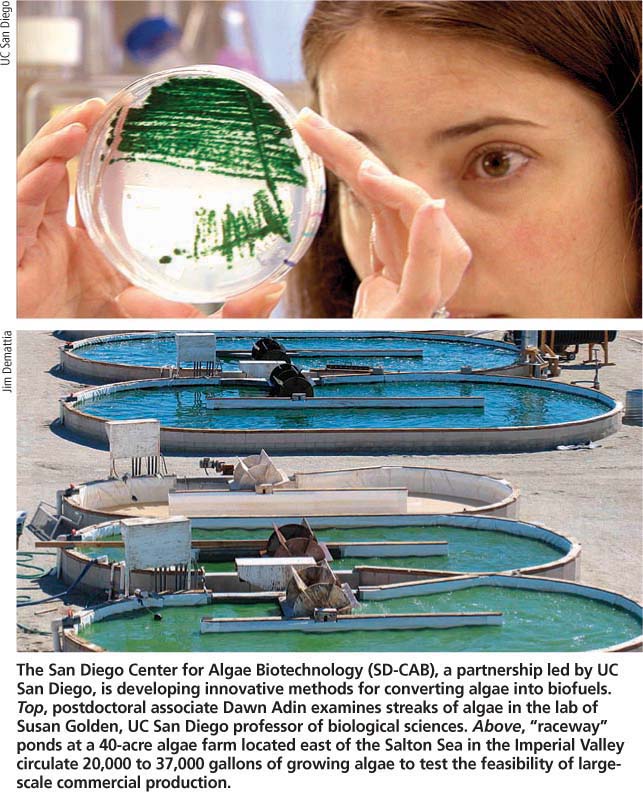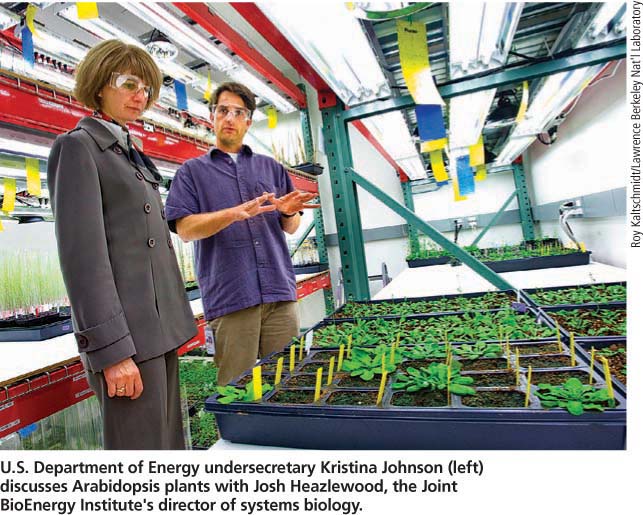All Issues
Biofuels caught in changing regulations: The role of land-use changes and carbon emissions is being debated by scientists and policymakers
Publication Information
California Agriculture 63(4):162-164.
Published October 01, 2009
PDF | Citation | Permissions
Full text
California's new regulations for transportation-fuel carbon emissions are shaking up the biofuels industry. When biofuels first took off, corn ethanol was touted as having the potential to cut carbon emissions by nearly 20%. But now the carbon intensity of corn ethanol can exceed that of gasoline under the state's Low Carbon Fuel Standard (LCFS), which was adopted in April 2009 and requires a 10% cut in greenhouse-gas emissions by 2020. Moreover, the impact of the new regulations could be widespread because they are set to be the basis of fuel standards elsewhere in the country and world.
“Two years ago crop biofuels were elevated as saviors, now they're seen as a negative force,” says Pamela Ronald, a UC Davis plant pathologist and vice president of feedstocks at the Emeryvillebased Joint BioEnergy Institute. “But the science hasn't changed at all.”
The San Diego Center for Algae Biotechnology (SD-CAB), a partnership led by UC San Diego, is developing innovative methods for converting algae into biofuels. Top, postdoctoral associate Dawn Adin examines streaks of algae in the lab of Susan Golden, UC San Diego professor of biological sciences. Above, “raceway” ponds at a 40-acre algae farm located east of the Salton Sea in the Imperial Valley circulate 20,000 to 37,000 gallons of growing algae to test the feasibility of large-scale commercial production.
What has changed is the way California estimates carbon emissions from transportation fuels. Under the LCFS, the carbon intensity of a fuel accounts for all emissions, from production to use. In addition, crop-based biofuels are accountable for emissions from converting wildlands to agriculture because this releases plant and soil carbon dioxide into the atmosphere.
Called land-use changes, these conversions can be direct or indirect. The former include conversions of nonagricultural land to cornfield, while the latter include conversions of soybean to corn field that in turn result in nonagricultural land–to-soybean conversions elsewhere, to satisfy global demand. Including indirect land-use change is what bumped up corn ethanol's average carbon intensity in the new regulations.
Controversy over indirect land-use change
Scientists are mixed on holding biofuels accountable for indirect land-use changes. Opponents include David Zilberman, a UC Berkeley agricultural and resource economist. “It's arbitrary, difficult to calculate and damaging in the long run,” he says. “It will impede the industry. People will think twice about investing in advanced, second-generation biofuels.”
On top of that, Zilberman does not think the new regulations will work. “It's like a band-aid. The state is trying to solve a global problem with a local solution,” he says. Instead, Zilberman advocates accounting for just direct carbon emissions combined with land protections such as ecological service–based fees or bans on biofuels produced from converted wildlands.
Similarly, Ronald and more than 100 other California scientists signed a letter in March 2009 asking the state not to penalize biofuels for indirect land-use changes. “It doesn't make sense to burn down tropical forests or use really fertile agricultural land for crop biofuels, because there are other ways to produce biofuels,” Ronald says. “The biofuel industry can plant perennial grasses rather than corn on marginal or abandoned agricultural lands.”
The biofuel industry also has options even under the new LCFS. For example, corn ethanol's carbon intensity varies with the production method, ranging from 10% more than gasoline for biorefineries fired by coal to nearly 20% less than gasoline for those fired by natural gas, and lower still for those fired by biomass. “The LCFS is a performance standard, so the industry can make changes to meet the requirements,” says Bryan Jenkins, a UC Davis biological and agricultural engineer who directs both the UC Davis Energy Institute and the California Renewable Energy Collaborative.
UC biofuel research centers
Bioenergy Research Group (BERG): Established in 2005, BERG is part of the UC Davis Energy Institute and includes more than 100 campus researchers from across the sciences and economics. BERG focuses on bioenergy development and policy, and includes work funded by a 5-year, $25 million grant from Chevron for developing affordable, renewable transportation fuels from farm and forest residues, urban wastes and crops grown specifically for energy (bioenergy.ucdavis.edu).
California Biomass Collaborative (CBC): CBC is part of the statewide California Renewable Energy Collaborative, which is managed by the UC Davis Energy Institute, and includes more than 500 members from government, industry, academia and environmental organizations. Established 2003, CBC has a 2-year, $800,000 grant from the California Energy Commission to coordinate the development of sustainable bioenergy, focusing on feedstock supply, energy conversion and environmental impacts (biomass.ucdavis.edu).
Energy Biosciences Institute (EBI): Established in 2007, EBI is a partnership of UC Berkeley, the Lawrence Berkeley National Laboratory and the University of Illinois. With a 10-year, $500 million commitment from BP, more than 300 researchers will initially focus on developing clean next-generation biofuel from sustainable sources such as nonfood crops. EBI provides data to help policymakers minimize the environmental impacts of biofuels. ( see page 165 ) ( www.energybioscienceinstitute.org ).
Joint BioEnergy Institute (JBEI): Led by Lawrence Berkeley National Laboratory, JBEI includes Sandia National Laboratories, Lawrence Livermore National Laboratory, UC Berkeley and UC Davis, and the Carnegie Institution for Science. One of three such centers nationwide funded by the U.S. Department of Energy (DOE), JBEI was established in 2008 with a 5-year, $135 million DOE grant, and focuses on developing the next generation of biofuels from plant biomass. ( www.jbei.org ).
San Diego Center for Algae Biotechnology (SD-CAB): Established in 2008, SD-CAB is a partnership of UC San Diego, Scripps Institution of Oceanography, The Scripps Research Institute and private industry. SD-CAB's goal is developing biofuels from algae, fast-growing plants that thrive in salt water and wastewater, and can yield up to 50 times more oil per acre than food crops (algae.ucsd.edu).
U.S. Department of Energy undersecretary Kristina Johnson (left) discusses Arabidopsis plants with Josh Heazlewood, the Joint BioEnergy Institute's director of systems biology.
Supporters of California's approach to biofuel standards include Chris Somerville, a UC Berkeley plant biologist who directs the UC Berkeley–based Energy Biosciences Institute (EBI). “In my opinion, the sole purpose of biofuels is to do something that's environmentally positive, and the argument for including indirect land-use change is good,” he says. However, Somerville cautions that further evaluation is needed before calculating carbon emissions from indirect land-use changes.
“The big question is how to calculate it — the data are not good,” Somerville says, adding that so far the state has set standards for only corn and sugar cane ethanol, and that EBI economics research will help the state set standards for additional biofuels. About 90% of conventional biofuels are bioethanols from a variety of starch- or sugar-rich crops, and the rest are biodiesels from vegetable oil, used cooking oil and animal fat.
Beyond California
The controversy over California's LCFS notwithstanding, more states may be poised to adopt similar regulations. Eleven Northeastern and Mid-Atlantic states have committed to developing a regional LCFS based on California's, and they expect to draft a memorandum of understanding (MOU) by the end of 2009. Likewise, British Columbia and Ontario signed a 2007 MOU to match California's LCFS.
The U.S. Environmental Protection Agency also included accounting for indirect land-use changes in a May 2009 proposal for new, national, renewable fuel standards. However, now the agency plans to wait 5 years for further evaluation, Somerville says. This approach is in keeping with that of the European Union, which in 2008 adopted a revised Fuel Quality Directive stipulating that biofuels must be produced sustainably but waiting until the end of 2010 to set any standards accounting for indirect land-use changes.
Potential biofuels, left to right. Biomass from eucalyptus, an oily Australian hardwood, could be heated at high temperatures to produce “bio-oil” for fuel. Native to the North American prairie, switchgrass has been used for conservation plantings and cattle feed; it produces high yields with minimal inputs, and can sequester carbon in soils for extended periods. Poplar hybrid trees are characterized by rapid growth and easy propagation. Rice hulls are currently being burned for electricity, and rice straw can be converted into low-cost ethanol. *After press run, original photo of wild rice replaced with image of Japonica species, predominant in California rice production. Credit: Wiki Commons.
Other aspects of transportation-fuel standards could also use re-evaluation, Jenkins says. For example, currently indirect land-use change applies only to biofuels, which could unfairly put them at a disadvantage. “Implementing sustainability standards only on bioenergy or biofuels may lead to market distortions for these types of energy,” Jenkins says. “Rather, standards should be applied across the energy sector.”
Advanced biofuels
Whatever the ultimate outcome, current trends in regulating crop biofuels increase the urgency of developing advanced biofuels from non-crop plant materials such as algae and grasses. Conventional bioethanol comes from plant-derived sugars that either are naturally abundant in sweet crops or are easily made from starches abundant in crops such as corn. While advanced or cellulosic bioethanol also comes from plant-derived sugars, these are made from lignocellulose and other cell-wall compounds that are currently difficult to break down efficiently.
Once production is optimized, however, advanced biofuels have the potential to decrease carbon emissions by 70%, according to the International Energy Association. Promising feedstocks for advanced biofuels include agricultural residue, which is plentiful in California; logging and tree thinning residue, which is plentiful in California and the Pacific Northwest; switchgrass, which is native to Midwest; and municipal green waste.
Beyond carbon
The new California regulations could also favor biofuels from nonfood crops that are grown either in rotation with food crops or as cover crops. Good candidates include grasses and mustards, which could yield bioethanol and biodiesel, respectively. Nonfood crops can also offer additional environmental benefits, such as controlling soil pests and clearing soil of selenium and other toxic elements or compounds. “Right now the focus is on global climate change but there are many other important environmental issues,” says James Stapleton, plant pathologist and natural resources coordinator for the UC Statewide Integrated Pest Management program. “We also have to consider soil, water and other air-quality issues” (see California Agriculture, Vol. 63, No. 1).
However, favoring nonfood crop biofuels could also have drawbacks. “Although this is politically expedient, it may very well limit industry innovation and farm production options,” Jenkins says.
As EBI's Somerville observes, nothing is black and white when it comes to biofuels. But he remains optimistic, adding that “we're having a good debate and going in a good direction.”







